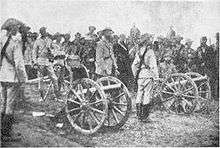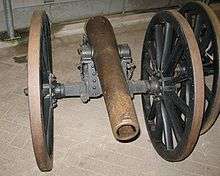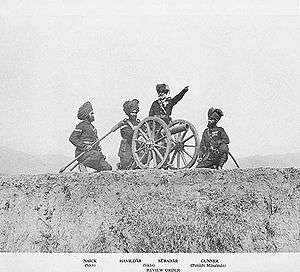RML 7 pounder Mountain Gun
| Ordnance RML 7 pounder Mk IV Mountain Gun | |
|---|---|
|
No. 4 (Hazara) Mountain Battery with RML 7 pounder circa. 1895 | |
| Type | Mountain gun |
| Place of origin |
|
| Service history | |
| In service | 1873 - 19? |
| Used by |
|
| Wars |
Anglo-Zulu War First Boer War Second Boer War Anglo-Aro War |
| Specifications | |
| Weight | 200 pounds (90.72 kg) barrel |
| Barrel length | 3 feet (914 mm) |
|
| |
| Shell |
7lb 11 oz (Shrapnel) 7lb 4oz (Common) 12lb 4oz (Double)[1] |
| Calibre | 3 inches (76.2 mm)[1] |
| Traverse | nil |
| Muzzle velocity | 968 ft/s (295 m/s) |
| Maximum firing range | 3,000 yd (2,700 m)[1] |
The Ordnance RML 7 pounder Mk IV "Steel Gun" was a rifled muzzle-loading mountain gun primarily used by the Indian Army. 7 pounder referred to the approximate weight of the shell it fired.
History
Development began in 1864 to replace the RBL 6 pounder 2.5-inch (64 mm) gun of 3cwt, which had proved too heavy for a mountain gun. Several Mks of 7 pounder RML of 2 cwt were tried in 1865 by boring out and rifling old SBML bronze guns, but were still too heavy.[2]
Several Mks of new steel barrels (the first British all-steel gun, hence the name "Steel Gun") were then produced of 190 lb (86 kg) and 150 lb (68 kg) but were not considered powerful enough.[2]
Mk IV of 200 lb (91 kg) with a longer bore was settled on for production in 1873.
It was superseded by the RML 2.5 inch Mountain Gun from 1879.
Combat Use
It could be assembled and a round loaded in 20 seconds. Its Common shell was considered ineffective. To give it a high angle capability, a Double shell was produced of increased length and containing a larger bursting charge. This was fired with a reduced charge, but the low muzzle velocity did not always arm the fuze, or prevent the over-long projectile from somersaulting. Shell rotation was effected by studs on the body of the shell. Elevation was by quoin or wedge and by screw. [3]
Anglo-Zulu War 1879
Britain deployed several guns mounted on Colonial (or "Kaffraria") carriages : light field gun type carriages with larger wider-spaced wheels suited for being horse-drawn across long grass.[4][5]
Second Anglo-Afghan War
_WDL11496.png)
An RML 7 pounder Mountain Gun appears to be present in a photograph by John Burke (photographer) from the Second Anglo-Afghan War (November 1878 - September 1880). The war began when Great Britain, fearful of what it saw as growing Russian influence in Afghanistan, invaded the country from British India. The first phase of the war ended in May 1879 with the Treaty of Gandamak, which permitted the Afghans to maintain internal sovereignty but forced them to cede control over their foreign policy to the British. Fighting resumed in September 1879, after an anti-British uprising in Kabul, and finally concluded in September 1880 with the decisive Battle of Kandahar.[6]
First Boer War 1880-1881
Britain deployed 4 guns mounted on standard small mountain carriages during the war.
Second Boer War 1899-1902


The gun was employed mounted on armoured trains and used by local militia forces early in the war.
It was also employed mounted on normal field carriages with larger wheels which increased mobility in the long grass and allowed it to be towed by horses.[3]
Anglo-Aro War
Column No. 4 of The British assembled Aro Field Force deployed one 7 pounder gun during the battles in and around Arochukwu.
See also
Surviving examples

Today, several examples of the guns still exist around the world :
- at the Regional Military Training Center in Darulaman Garrison, Kabul. The garrison is near the palaces, and south of the Bala Hissar where the British had their headquarters during the Anglo-Afghan wars.
- A gun at Royal Armouries, Fort Nelson, Hampshire, UK
- Royal Artillery Museum, London
- South African National Museum of Military History, Johannesburg, South Africa
Notes and references
- 1 2 3 Hall, December 1972
- 1 2 Ruffell
- 1 2 Hall, June 1971
- ↑ Major D.D. Hall, "ARTILLERY IN THE ZULU WAR - 1879", in The South African Military History Society Military History Journal, Vol 4 No 4 - Zulu War Centenary Issue - January 1979
- ↑ John McAdam, FRGS, "The Role of the Royal Artillery during the Anglo Zulu War "
- ↑ Elephant and Mule Battery ("Dignity & Impudence") WDL11496.png caption, Library of Congress
Bibliography
- Major Darrell D Hall, "Guns in South Africa 1899-1902" in The South African Military History Society Military History Journal - Vol 2 No 1, June 1971
- Major Darrell D. Hall, "Field Artillery of the British Army 1860-1960. Part I, 1860 - 1900" in The South African Military History Society. Military History Journal - Vol 2 No 4, December 1972 (web page is incorrectly titled 1900-1914)
- W. L. Ruffell, The Gun - Rifled Ordnance: Mountain Artillery. RML 7 pounder
Further reading
- Major D.D. Hall, The South African Military History Society Military History Journal Vol 4 No 4, December 1978. "ARTILLERY IN THE ZULU WAR - 1879"
- Major D.D. Hall, The South African Military History Society Military History Journal - Vol 5 No 2, December 1980. "The Artillery of the First Anglo-Boer War 1880 - 1881"
- MAJOR G. TYLDEN, ED, The South African Military History Society Military History Journal - Vol 1 No 2, June 1968. Further Notes on Early Rhodesian Military Units and Early Rhodesia's Weapons
External links
| Wikimedia Commons has media related to RML 7 pounder Mountain Gun. |
- Diagram of carriage, 7-pounder gun of 200 Lbs Mk I and Text at Victorian Forts and Artillery website.
